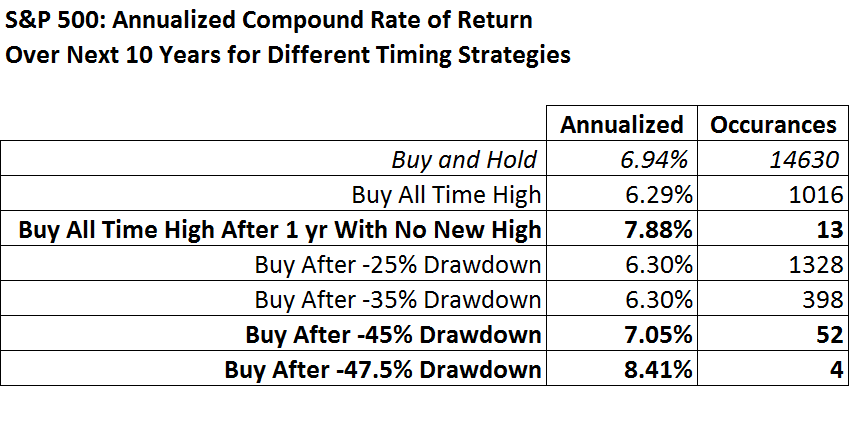Market timing is hard. In fact, there are very few strategies that have historically beaten a buy-and-hold (B&H) index strategy. The simple strategies that do appear to beat buy-and-hold do NOT have a lot of sample size, so they better be logical to you. As we will show below, there are two simple strategies that do offer above average market returns for an investor historically, but they don’t come around every day.
For reference, the average 10 year annualized return for the S&P 500 has been 6.94% since 1950. That is our benchmark.
Our timing strategies fall into two camps. First, buy large declines, a mean reversion strategy predicated on the belief that a decline in prices is a great value opportunity. Second, only buy when the market is making new highs. If you look at the table below, you can see that neither strategy by itself is particular effective, or beats B&H until you start using more extreme versions.
Buying the stock market when it is making all-time highs produces inferior returns relative to buy-and-hold. It works only if the market has NOT made an all-time highs in the prior year. But since 1950 this set of conditions has only occurred 13 times. That said, this strategy has produced 94 basis point of excess return over B&H. It’s also somewhat logical when you consider supply and demand. If the market just starts making new highs after a prolonged period of sideways or downward movement, there are enough people who still have not bought in yet. There remains some market capacity to discount future positive events. Not everyone is bullish yet. It also is a strategy that means you are not likely to invest right before financial Armageddon, though there is obviously no guarantee.
By contrast, buying declines in the market has worked only when you get really large declines. If the market declines 25% or 35%, you do not beat buy-and-hold. Buying any of the 52 days that the S&P 500 declined more than -45%, has produced 10 year returns that are only 11 basis points better than B&H. Its only if you bought on the 4 days in the last 7 decades that the market declined more than -47.5% that you really do much better than buy-and-hold. That’s once every 17.5 years, so be prepared to keep your powder dry a long time. This strategy also needs to come with the caveat that the few times it doesn’t work can be painful. Using this in Japan in the 1990s or in the US during the 1930s would not have worked. Markets don’t always mean-revert. Just because something has gone down -47.5% does not mean it can go down another 50% or more.
